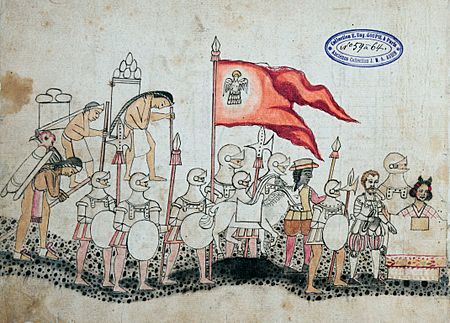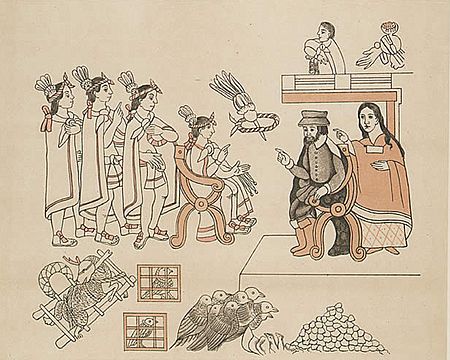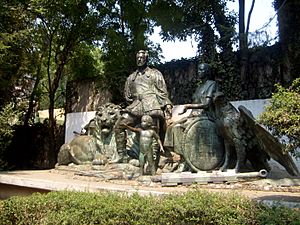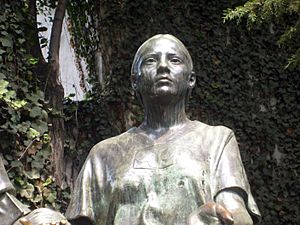La Malinche facts for kids
Quick facts for kids
Marina
|
|
|---|---|

Malintzin, in an engraving dated 1885.
|
|
| Born | c. 1500 |
| Died | before February 1529 (aged 28–29) |
| Other names | Malintzin, La Malinche |
| Occupation | Interpreter, advisor, intermediary |
| Known for | Role in the Spanish conquest of the Aztec Empire |
| Spouse(s) | Juan Jaramillo |
| Children | Martín Cortés María |
Marina [maˈɾina] or Malintzin [maˈlintsin] (c. 1500 – c. 1529), more popularly known as La Malinche [la maˈlintʃe], a Nahua woman from the Mexican Gulf Coast, became known for contributing to the Spanish conquest of the Aztec Empire (1519–1521), by acting as an interpreter, advisor, and intermediary for the Spanish conquistador Hernán Cortés. She was one of 20 enslaved women given to the Spaniards in 1519 by the natives of Tabasco. Cortés chose her as a consort, and she later gave birth to his first son, Martín – one of the first Mestizos (people of mixed European and Indigenous American ancestry) in New Spain.
La Malinche's reputation has shifted over the centuries, as various peoples evaluate her role against their own societies' changing social and political perspectives. Especially after the Mexican War of Independence, which led to Mexico's independence from Spain in 1821, dramas, novels and paintings portrayed her as an evil or scheming temptress. In Mexico today, La Malinche remains a powerful icon and serves as the symbolic mother of the new Mexican people. The term malinchista refers to a disloyal compatriot, especially in Mexico.
Contents
Name
Malinche is known by many names. She was baptized as a Catholic by the Spaniards and then named "Marina", and was referred to as such by the Spaniards, often preceded with honorific doña. The Nahua called her 'Malintzin', derived from 'Malina' (a Nahuatl rendering of her Spanish name) and the honorific suffix -tzin. According to historian Camilla Townsend, the vocative suffix -e is sometimes added at the end of the name, giving the form Malintzine, which would be shortened to 'Malintze', and heard by the Spaniards as 'Malinche'. Another possibility is that the Spaniards simply did not hear the 'whispered' -n of the name Malintzin.
Her name at birth is unknown. Since at least the 19th century, she is believed to have originally been named 'Malinalli' (Nahuatl for 'grass'), after the day sign on which she was supposedly born. Accordingly, Marina was chosen as her Christian name because of its phonetic similarity. Modern historians have rejected such mythic suggestions. They note that the Nahua associate the day sign 'Malinalli' with bad or 'evil' connotations, and they are known to avoid using such day signs as personal names. Moreover, there would be little reason for the Spaniards to ask the natives what their personal names were before they were christened with new Catholic saints' names.
The title 'Tenepal' was often assumed to be part of her name. In the annotation made by Nahua historian Chimalpahin on his copy of Gómara's biography of Cortés, 'Malintzin Tenepal' is used repeatedly in reference to Malinche. According to linguist and historian Frances Karttunen, Tenepal is probably derived from the Nahuatl root tene, which means “lip-possessor, one who speaks vigorously”, or “one who has a facility with words”, and postposition -pal, which means “by means of”. Historian James Lockhart, however, suggests that 'Tenepal' might be derived from tenenepil or "somebody's tongue". In any case, 'Malintzin Tenepal' appears to have been intended as a calque of Spanish doña Marina la lengua, with la lengua ("the interpreter", literally "the tongue") being her Spanish sobriquet.
Life
Background

Malinche's birthdate is unknown, but it is estimated to be around 1500, and likely no later than 1505. She was born in an altepetl that was either a part or a tributary of a Mesoamerican state whose center was located on the bank of the Coatzacoalcos River to the east of the Aztec Empire. Records disagree about the exact name of the altepetl where she was born. In three unrelated legal proceedings that occurred not long after her death, various witnesses who claimed to have known her personally, including her daughter, said that she was born in Olutla. The probanza of her grandson also mentioned Olutla as her birthplace. Her daughter added that the altepetl of Olutla was related to Tetiquipaque, although the nature of this relationship is unclear. In the Florentine Codex, Malinche's homeland is mentioned as "Teticpac", which is most likely the singular form of Tetiquipaque. Gómara writes that she came from "Uiluta" (presumably a variant of Olutla). He departs from other sources by writing that it was in the region of Jalisco. Díaz, on the other hand, gives "Painalla" as her birthplace.
Her family is reported to have been of noble background; Gómara writes that her father was related to a local ruler, while Díaz recounts that her parents were rulers. Townsend notes that while Olutla at the time probably had a Popoluca majority, the ruling elite, which Malinche supposedly belonged to, would have been Nahuatl-speaking. Another hint that supports her noble origin is her apparent ability to understand the courtly language of tecpillahtolli (“lordly speech”), a Nahuatl register that is significantly different from the commoner's speech and has to be learned. The fact that she was often referred to as a doña, at the time a term not commonly used in Spain, indicates that she was viewed as a noblewoman. But she may have been given this honorific by the Spanish because of recognition of her important role in the conquest.
Malinche was probably between the ages of 8 and 12 when she was either sold or kidnapped into slavery. Díaz wrote that after her father's death, she was given away to merchants by her mother and stepfather so that their son (Malinche's stepbrother) would have the rights of heir. Scholars, historians and literary critics alike, have cast doubt upon Díaz's account of her origin, in large part due to his strong emphasis on Catholicism throughout his narration of the events.
In particular, historian Sonia Rose de Fuggle analyzes Díaz's over-reliance on polysyndeton (which mimics the sentence structure of a number of Biblical stories) as well as his overarching portrayal of Malinche as an ideal Christian woman. But Townsend believes that it was likely that some of her people were complicit in trafficking her, regardless of the reason. Malinche was taken to Xicalango, a major port city in the region. She was later purchased by a group of Chontal Maya who brought her to the town of Potonchán. It was here that Malinche started to learn the Chontal Maya language, and perhaps also Yucatec Maya. Her acquisition of the language later enabled her to communicate with Jerónimo de Aguilar, another interpreter for Cortes who also spoke Yucatec Maya, as well as his native Spanish.
The Conquest of Mexico
Moteucçoma was told how the Spaniards were bringing along with them a Mexica [Nahuatl-speaking] Indian woman called Marina, a citizen of the settlement of Teticpac, on the shore of the North Sea [Caribbean], who served as interpreter and said in the Mexican language everything that Captain don Hernando Cortés told her to.
Early in his expedition to Mexico, Cortés was confronted by the Maya at Potonchán. In the ensuing battle, the Mayas suffered significant loss of lives and asked for peace. In the following days, they presented the Spaniards with gifts of food and gold, as well as twenty enslaved women, including Malinche. The women were baptized and distributed among Cortés's men, who expected to use them as servants. Malinche was given to Alonso Hernández Puertocarrero, one of Cortés's captains. He was a first cousin to the count of Cortés's hometown, Medellín.
Malinche's language skills were discovered when the Spaniards encountered the Nahuatl-speaking people at San Juan de Ulúa. Moctezuma's emissaries had come to inspect the peoples, but Aguilar could not understand them. Historian Gómara wrote that, when Cortés realized that Malinche could talk with the emissaries, he promised her “more than liberty” if she would help him find and communicate with Moctezuma. Cortés took Malinche from Puertocarrero. He was later given another Indigenous woman before he returned to Spain.
Aided by Aguilar and Malinche, Cortés talked with Moctezuma's emissaries. The emissaries also brought artists to make paintings of Malinche, Cortés, and the rest of the group, as well as their ships and weapons, to be sent as records for Moctezuma. Díaz later said that the Nahua addressed Cortés as "Malinche"; they apparently took her as a point of reference for the group.
From then on, Malinche worked with Aguilar to bridge communication between the Spaniards and the Nahua; Cortés would speak Spanish with Aguilar, who translated into Yucatec Maya for Malinche, who in turn translated into Nahuatl, before reversing the process. The translation chain grew even longer when, after the emissaries left, the Spaniards met the Totonac, whose language was not understood by either Malinche or Aguilar. There, Malinche asked for Nahuatl interpreters. Karttunen remarks that "it is a wonder any communication was accomplished at all", for Cortés's Spanish words had to be translated into Maya, Nahuatl, and Totonac before reaching the locals, whose answers went back through the same chain. Meeting with the Totonac was how the Spaniards first learned of opponents to Moctezuma.
After founding the town of Villa Rica de la Vera Cruz in order to be freed from the legal restriction of what was supposed to be an exploratory mission, the Spaniards stayed for two months in a nearby Totonac settlement. They secured a formal alliance with the Totonac and prepared for a march toward Tenochtitlan.
The first major polity that they encountered on the way to Tenochtitlan was Tlaxcala. Although the Tlaxcaltec were initially hostile to the Spaniards and their allies, they later permitted the Spaniards to enter the city. The Tlaxcalans negotiated an alliance with the Spaniards through Malinche and Aguilar. Later Tlaxcalan visual records of this meeting feature Malinche as a prominent figure. She appears to bridge communication between the two sides, as the Tlaxcalan presented the Spaniards with gifts of food and noblewomen to cement the alliance. After several days in Tlaxcala, Cortés continued the journey to Tenochtitlan by the way of Cholula. By then he was accompanied by a large number of Tlaxcalan soldiers.
The Spaniards were received at Cholula and housed for several days. The explorers claimed that the Cholulans stopped giving them food, dug secret pits, built a barricade around the city, and hid a large Aztec army in the outskirts to prepare for an attack against the Spaniards. Somehow, the Europeans learned of this and, in a preemptive strike, assembled and massacred the Cholulans. Later accounts claimed that Malinche had uncovered the plot. According to Díaz, she was approached by a Cholulan noblewoman who promised her a marriage to the woman's son if she were to switch sides. Pretending to go along with the suggestion, Malinche was told about the plot, and later reported all the details to Cortés.
In later centuries, this story has often been cited as an example of Malinche's “betrayal” of her people. But modern historians such as Hassig and Townsend have suggested that Malinche's "heroic" discovery of the purported plot was likely already a fabricated story intended to provide Cortés with political justification for his actions, to distant Spanish authorities. In particular, Hassig suggests that Cortés, seeking stronger native alliances leading to the invasion of Tenochtitlan, worked with the Tlaxcalans to coordinate the massacre. Cholula had supported Tlaxcala before joining the Aztec Empire one or two years prior, and losing them as an ally had been a severe blow to the Tlaxcalans. Their state was now completely encircled by the Aztecs. Hassig and other historians assert that Tlaxcalans considered the attack on the Cholulans as a "litmus test" of the Spanish commitment to them.
The combined forces reached Tenochtitlan in early November 1519, where they were met by Moctezuma on a causeway leading to the city. Malinche was in the middle of this event, translating the conversation between Cortés and Moctezuma. Gomara writes that Moctezuma was "speaking through Malinche and Aguilar", although other records indicate that Malinche was already translating directly, as she had quickly learned some Spanish herself. Moctezuma's flowery speech, delivered through Malinche at the meeting, has been claimed by the Spaniards to represent a submission, but this interpretation is not followed by modern historians. The deferential nature of the speech can be explained by Moctezuma's usage of tecpillahtolli, a Nahuatl register known for its indirection and complex set of reverential affixes. Despite Malinche's apparent ability to understand tecpillahtolli, it is possible that some nuances were lost in translation. The Spaniards, deliberately or not, may have misinterpreted Moctezuma's words.
Tenochtitlán fell in late 1521 and Marina's son by Cortes, Martín Cortés was born in 1522. During this time Malinche or Marina stayed in a house Cortés built for her in the town of Coyoacán, eight miles south of Tenochtitlán. The Aztec capital city was being redeveloped to serve as Spanish-controlled Mexico City. Cortés took Marina to help quell a rebellion in Honduras in 1524–1526, when she again served as interpreter (she may have known Maya dialects beyond Chontal and Yucatán). While in the mountain town of Orizaba in central Mexico, she married Juan Jaramillo, a Spanish hidalgo. Some contemporary scholars have estimated that she died less than a decade after the conquest of Mexico-Tenochtitlan, at some point before February 1529. She was survived by her son Don Martín, who would be raised primarily by his father's family, and a daughter Doña María, who would be raised by Jaramillo and his second wife Doña Beatriz de Andrada.
Although Martín was Cortés's first-born son and eventual heir, his relation to Marina was poorly documented by prominent Spanish historians such as Francisco López de Gómara. He never referred to Marina by name, even in her work as Cortés's translator. Even during Marina's lifetime, she spent little time with Martín. But many scholars and historians have marked her multiracial child with Cortés as the symbolic beginning of the large mestizo population that developed in Mesoamerica.
Role in the conquest of Mexico

For the conquistadores, having a reliable interpreter was important enough, but there is evidence that Marina's role and influence were larger still. Bernal Díaz del Castillo, a soldier who, as an old man, produced the most comprehensive of the eye-witness accounts, the Historia verdadera de la conquista de la Nueva España ("True Story of the Conquest of New Spain"), speaks repeatedly and reverentially of the "great lady" Doña Marina (always using the honorific title Doña). "Without the help of Doña Marina", he writes, "we would not have understood the language of New Spain and Mexico." Rodríguez de Ocaña, another conquistador, relates Cortés' assertion that after God, Marina was the main reason for his success.
The evidence from Indigenous sources is even more interesting, both in the commentaries about her role, and in her prominence in the codex drawings made of conquest events. Although to some Marina may be known as a traitor, she was not viewed as such by all the Tlaxcalan. In some depictions they portrayed her as "larger than life," sometimes larger than Cortés, in rich clothing, and an alliance is shown between her and the Tlaxcalan instead of them and the Spaniards. They respected and trusted her and portrayed her in this light generations after the Spanish conquest.
In the Lienzo de Tlaxcala (History of Tlaxcala), for example, not only is Cortés rarely portrayed without Marina poised by his side, but she is shown at times on her own, seemingly directing events as an independent authority. If she had been trained for court life, as in Díaz's account, her relationship to Cortés may have followed the familiar pattern of marriage among native elite classes. The role of the Nahua wife acquired through an alliance would have been to assist her husband achieve his military and diplomatic objectives.
Today's historians give great credit to Marina's diplomatic skills, with some "almost tempted to think of her as the real conqueror of Mexico." In fact, old conquistadors on various occasions recalled that one of her greatest skills had been her ability to convince other natives of what she could perceive, that it was useless in the long run to stand against Spanish metal (arms) and Spanish ships. In contrast to earlier parts of Díaz del Castillo's account, after Marina began assisting Cortés, the Spanish were forced into combat on one more occasion.
Had La Malinche not been part of the Conquest of Mexico for her language skills, communication between the Spanish and the Indigenous peoples would have been much harder. La Malinche knew how to speak in different registers and tones among certain Indigenous tribes and classes of people. For the Nahua audiences, she spoke rhetorically, formally, and high-handedly. This shift into formality gave the Nahua the impression that she was a noblewoman who knew what she was talking about.
Image in contemporary Mexico
Malinche's image has become a mythical archetype that Hispanic American artists have represented in various forms of art. Her figure permeates historical, cultural, and social dimensions of Hispanic American cultures. In modern times and in several genres, she is compared with the La Llorona (folklore story of the woman weeping for lost children), and the Mexican soldaderas (women who fought beside men during the Mexican Revolution) for their brave actions.
La Malinche's legacy is one of myth mixed with legend, and the opposing opinions of the Mexican people about the legendary woman. Some see her as a founding figure of the Mexican nation, while others continue to see her as a traitor—as may be assumed from a legend that she had a twin sister who went North, and from the pejorative nickname La Chingada associated with her twin.
Feminist interventions into the figure of Malinche began in 1960s. The work of Rosario Castellanos was particularly significant; Chicanas began to refer to her as a "mother" as they adopted her as symbolism for duality and complex identity. Castellanos's subsequent poem "La Mallinche" recast her not as a traitor but as a victim. Mexican feminists defended Malinche as a woman caught between cultures, forced to make complex decisions, who ultimately served as a mother of a new race.
Today in Mexican Spanish, the words malinchismo and malinchista are used to denounce Mexicans who are perceived as denying their own cultural heritage by preferring foreign cultural expressions.
Some historians believe that La Malinche saved her people from the Aztecs, who held a hegemony throughout the territory and demanded tribute from its inhabitants. Some Mexicans also credit her with having brought Christianity to the New World from Europe, and for having influenced Cortés to be more humane than he would otherwise have been. It is argued, however, that without her help, Cortés would not have been successful in conquering the Aztecs as quickly, giving the Aztec people enough time to adapt to new technology and methods of warfare. From that viewpoint, she is seen as one who betrayed the Indigenous people by siding with the Spaniards. Recently a number of feminist Latinas have decried such a categorization as scapegoating.
President José López Portillo commissioned a sculpture of Cortés, Doña Marina, and their son Martín, which was placed in front of Cortés' house in the Coyoacan section of Mexico City. Once López Portillo left office, the sculpture was removed to an obscure park in the capital.
See also
 In Spanish: La Malinche para niños
In Spanish: La Malinche para niños




